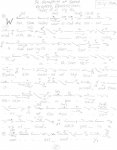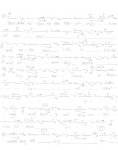GabrielCremeens
Music Director at St. George, Albuquerque, NM
Good afternoon to all,
Attached to this post is the second draft of a recent composition that I did for July 19th - the Translation of the Relics of St. Seraphim of Sarov.
The piece is through-composed, given that there was no "Greek original" to go off of. (At least to my knowledge.) I believe that the service (found in the back of the HTM Menaion for the month of July) was either composed in English by the Monastery, or translated from a Russian source.
Either way, there was no Greek original to base an adaptation off of. Given this, and the fact that St. Seraphim of Sarov is so well-loved throughout the Orthodox world, and that his feast day (at least in the HTM Menaion) is a "big deal", so to speak, with resurrectional theotokia, litya hymns, readings, and so forth, I did my best to make this doxastikon "nice". Thus, it does employ multiple old sticheraric theseis, and a great deal of text painting - beyond that of normal, everyday Doxastika. This might be a point of contention for some, but I wanted to mention my reasons for doing this up front, just so that we're all on the same page.
That being said, the composition is attached. There are two lines at the end of page 3 that I feel are better than my original solutions to those pieces of text. The original ending, especially, felt very short and anticlimactic after such a long Doxastikon, so I found an alternate ending thesis. Of course, any better suggestions are always appreciated.
A few ideas or places that I feel need work (not that other places don't...)
1) Page 1, line 8: I believe that the vareia-ison-apostrophos-apli of "er" ("beholder") should be replaced with a simple apostrophos/apli, and then marked with a 4, so that the next downbeat falls on the syllable "mys" ("mysteries of God").
2) Page 2, line 5: I believe that the apostrophos/apli might better be replaced with apostrophos/dipli, and then given a tetrasimos rhythm, in order to avoid putting a trisimo there (which I forgot to mark). Somehow it doesn't feel right to me. Perhaps that's just me, though.
3) Page 2, line 8: The klasma on the syllable "spir" (of "spiritual", near the bottom of page 2, I believe), should be removed, I think, and that particular word should be given a trisimos rhythm.
In Christ,
Gabriel
P.S. Apologies that these are not in a pdf. I am not using my normal computer at this moment.
Attached to this post is the second draft of a recent composition that I did for July 19th - the Translation of the Relics of St. Seraphim of Sarov.
The piece is through-composed, given that there was no "Greek original" to go off of. (At least to my knowledge.) I believe that the service (found in the back of the HTM Menaion for the month of July) was either composed in English by the Monastery, or translated from a Russian source.
Either way, there was no Greek original to base an adaptation off of. Given this, and the fact that St. Seraphim of Sarov is so well-loved throughout the Orthodox world, and that his feast day (at least in the HTM Menaion) is a "big deal", so to speak, with resurrectional theotokia, litya hymns, readings, and so forth, I did my best to make this doxastikon "nice". Thus, it does employ multiple old sticheraric theseis, and a great deal of text painting - beyond that of normal, everyday Doxastika. This might be a point of contention for some, but I wanted to mention my reasons for doing this up front, just so that we're all on the same page.
That being said, the composition is attached. There are two lines at the end of page 3 that I feel are better than my original solutions to those pieces of text. The original ending, especially, felt very short and anticlimactic after such a long Doxastikon, so I found an alternate ending thesis. Of course, any better suggestions are always appreciated.
A few ideas or places that I feel need work (not that other places don't...)
1) Page 1, line 8: I believe that the vareia-ison-apostrophos-apli of "er" ("beholder") should be replaced with a simple apostrophos/apli, and then marked with a 4, so that the next downbeat falls on the syllable "mys" ("mysteries of God").
2) Page 2, line 5: I believe that the apostrophos/apli might better be replaced with apostrophos/dipli, and then given a tetrasimos rhythm, in order to avoid putting a trisimo there (which I forgot to mark). Somehow it doesn't feel right to me. Perhaps that's just me, though.
3) Page 2, line 8: The klasma on the syllable "spir" (of "spiritual", near the bottom of page 2, I believe), should be removed, I think, and that particular word should be given a trisimos rhythm.
In Christ,
Gabriel
P.S. Apologies that these are not in a pdf. I am not using my normal computer at this moment.
Attachments
Last edited:



